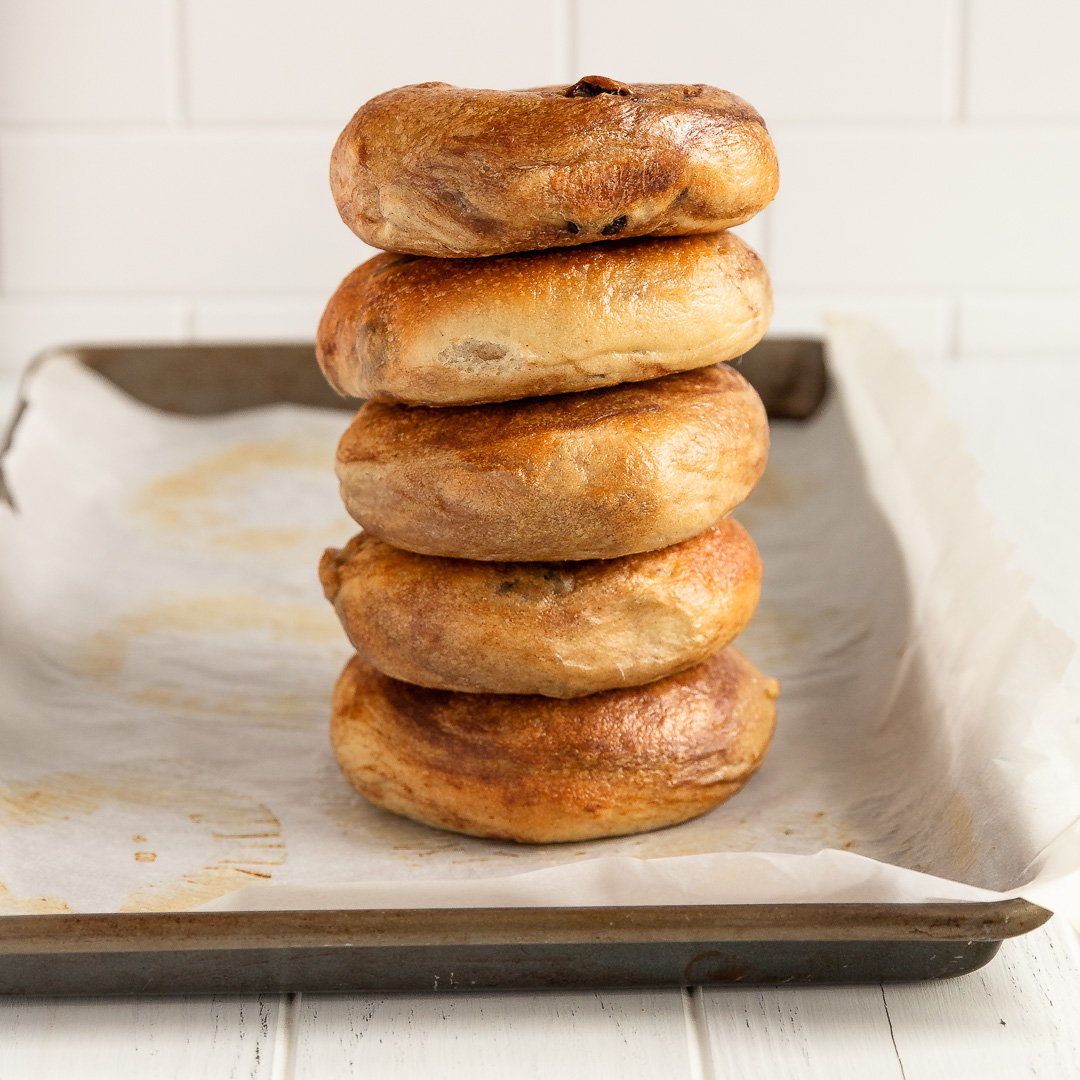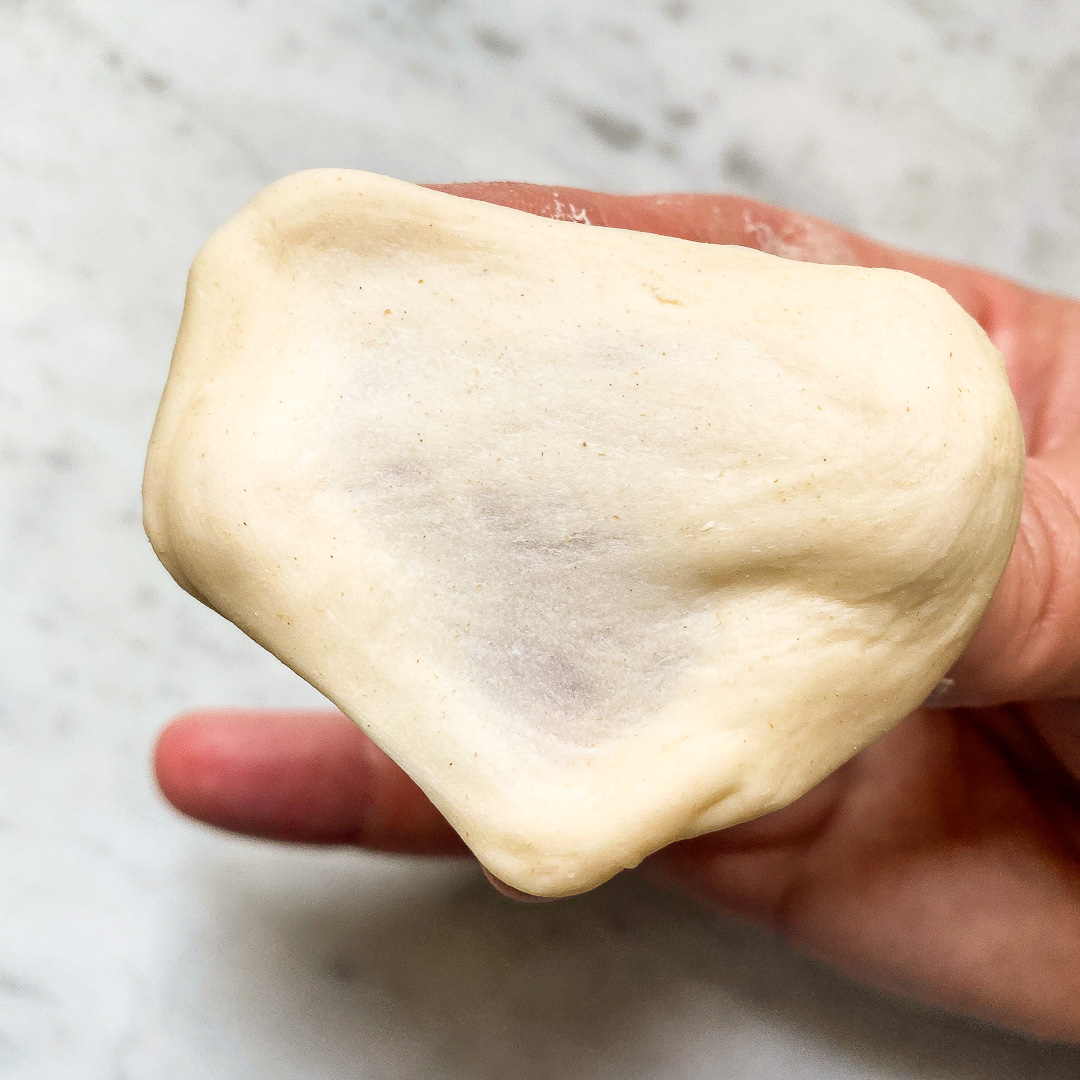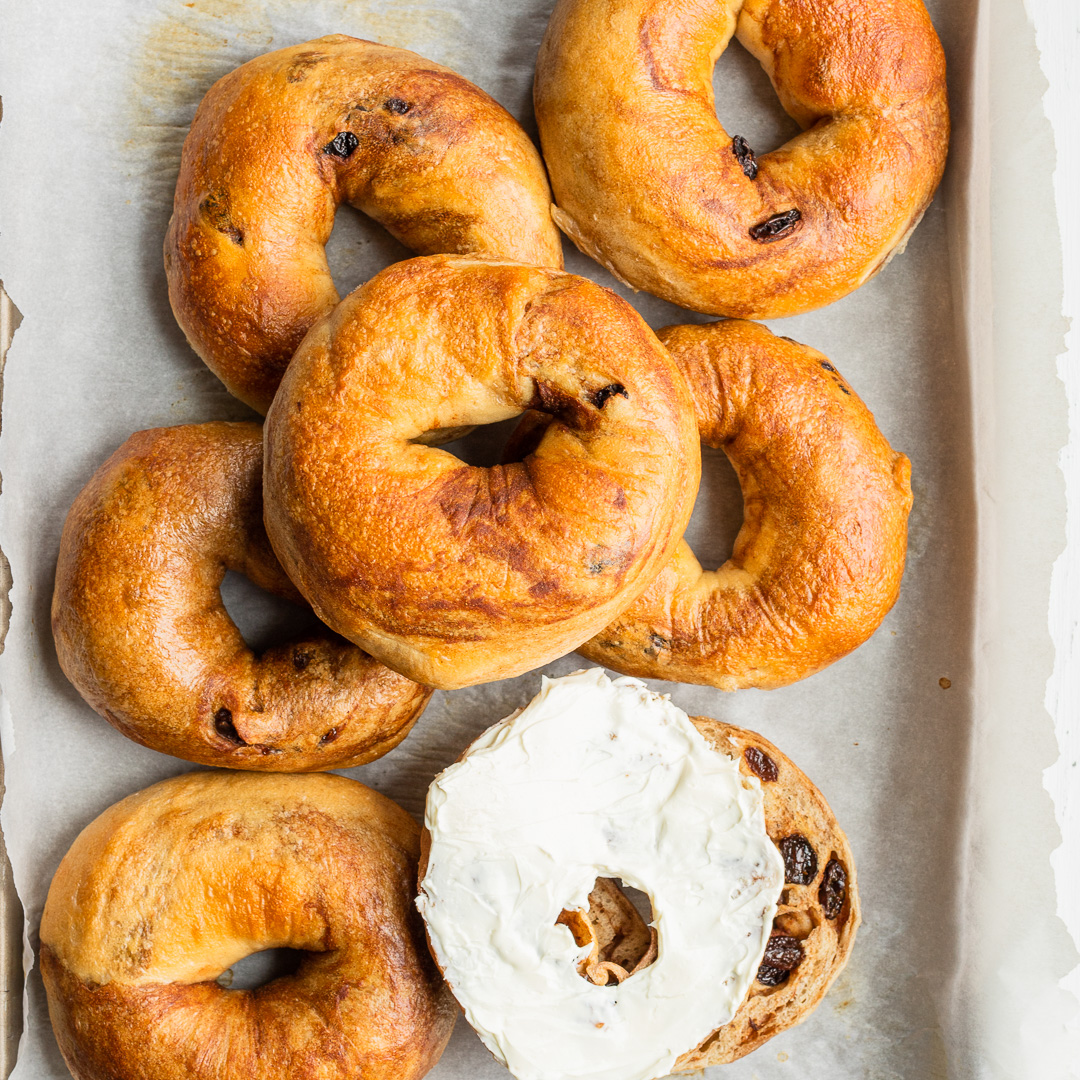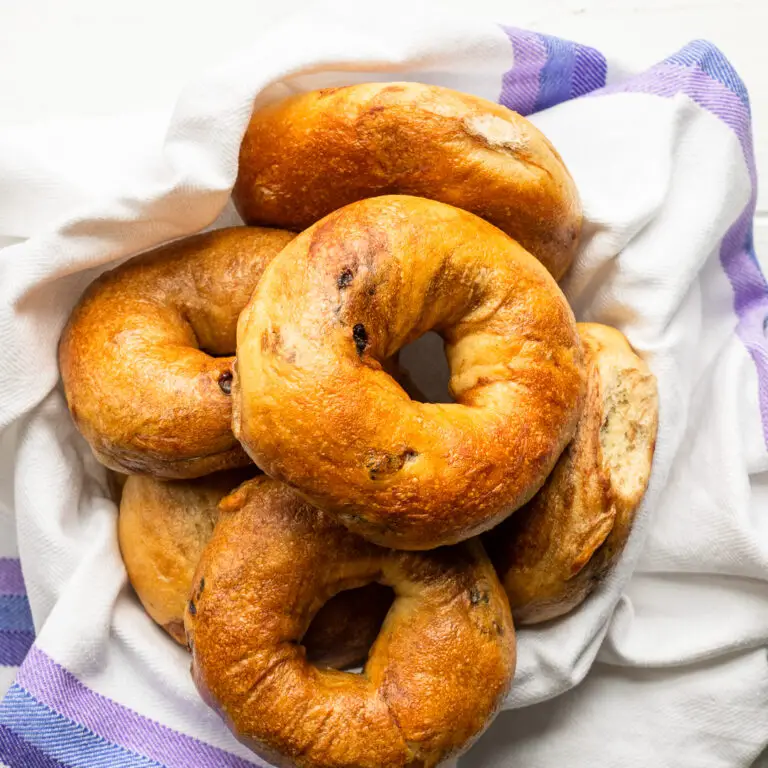This post may contain affiliate links. As an Amazon Associate, I earn from qualifying purchases. For more information, please visit my Privacy Policy.
A Homemade Cinnamon Raisin Bagel!?!
I never made bagels until I went to culinary school. For whatever reason, I thought that they must be difficult to make. I was amazed to learn in school that they are actually quite simple. And that makes sense – there’s not much to a bagel. We never made cinnamon raisin bagels in culinary school, so this recipe became a task of love for me.

What Makes a Bagel a Bagel?
That said, there is one critical ingredient to make a true New York bagel: malt. A true New York bagel requires (yes, I said it: requires) malt, whether in syrup or powder form.
What is Malt?
Malt powder (or syrup) is a sweet derivative of roasted barley. In this recipe (and most bagel recipes), we use non-diastatic malt, which means that the malt was heated to the point of killing the enzymes contained in it. Diastatic malt therefore has active enzymes in it and is used in bread recipes to assist with rising and conditioning the dough. Non-diastatic malt, which is more commonly used in bagels, simply provides a touch of sweetness and deeper color in the bagels without affecting the rise or dough consistency.
For more information using malt powder versus malt barley syrup, check out my Bagels post.
In this recipe, the malt is therefore not a key ingredient in terms of the structure of the bagel. It is, however, a key ingredient in terms of flavor. There are recipes out there that use “substitutes” for malt such as molasses and brown sugar. Those bagels may come out good, but they are not (I repeat NOT!) true New York bagels.
We Don’t “Love” Substitutes
And remember: a substitute is just that. It is a second-best replacement for an ideal ingredient. If you are going to take the time and energy to make something, don’t you want it to be the best? I do. So, if you are going to make these bagels, plan in advance and buy the non-diastatic malt powder. It is readily available at King Arthur Baking Company (where I buy it) and sometimes Amazon. You can also buy other brands at Amazon, such as Mondernist Pantry. I prefer the powder to malt barley syrup because the powder is easier to work with and has a longer shelf life.

How Are Cinnamon Raisin Bagels Different from Plain Bagels?
This recipe is based on the bagel recipe I was provided in culinary school at the International Culinary Center in New York City, which is now part of the Institute of Culinary Education. I LOVE this recipe and have made some stupendous bagels with it. However, in school, we did not make cinnamon raisin bagels. We made a plain bagel and were able to use various seed toppings. To adapt that recipe for cinnamon raisin, I had to make one alteration – more yeast. (Nerd alert: cinnamon slows down yeast development, so I had to compensate for that to achieve a perfectly doughy and chewy result.)
I initially added cinnamon and just kneaded it into the dough. Because the cinnamon was so dry, it was difficult to get it to incorporate into the dough. The end result was a somewhat dry bagel. I then decided that the cinnamon would probably knead in better if it were wet. So, I added water to the cinnamon to create a paste. Plus, I realized that the wet cinnamon would prevent the cinnamon from absorbing moisture from the bagel dough. Voila!!!

This recipe comes together very easily with a mixer. I use a KitchenAid 5 Quart Professional. If you have a less powerful mixer like the KitchenAid Artisan, the dough may be too stiff and cause your motor to overheat and turn off at some point during the kneading process. If the motor sounds like it is overworking, I suggest turning it off and finish kneading by hand. It’s actually a good workout and is quite therapeutic!
As I said, these cinnamon raisin bagels are super simple to make:
- Mix Ingredients. Mix your yeast with the water and approximately 1 teaspoon of the sugar. Once foamy, add the flour, malt powder, and sugar. (If you are using instant yeast, just add it with the water and all the sugar to the rest of the ingredients.) It will take a few minutes for the dough to come together. Resist the urge to add more water. If, after about 4 minutes, the dough has not come together, add 1 teaspoon of water. Unless you live in the dessert or it’s a particularly dry day, you should not need more water than that.
- Knead and Add Salt. By about the 7 minute mark, slow down the mixer and start adding the salt. (Nerd alert: We wait to add the salt because salt, when first combined with yeast, can kill some of the yeast or slow the yeast development in the dough. Once the dough is formed, the yeast reacts much more kindly to the salt, and it actually helps the yeast develop.) Knead for about 5 more minutes.
- Windowpane Test. Do the windowpane test to make sure the gluten in the dough is fully developed.
- Add Cinnamon and Raisins. Once the dough passes the windowpane test, add your “cinnamon paste”. Knead the dough until it is almost marbled. Then add the raisins and knead until fully incorporated. (I usually get some of the raisins kneaded in with the mixer and finish it off kneading by hand.)
- Shape and Rest. Shape the bagels. The video in this post shows how to shape them. Cover in plastic wrap and pop them into the refrigerator.
- Refrigerate overnight. This helps the flavor develop further while slowing down the fermentation process.
- Boil and Bake. Remove the bagels from the refrigerator and allow them to come to room temperature, approximately 90-120 minutes. This is longer than my plain Bagel recipe because the cinnamon in the dough slows the yeast down. Then boil them briefly (30 seconds on each side) in water and malt before baking. I find using Alexa or Siri takes longer than just setting a timer, so I use a TimeStack from Thermoworks which lets me set multiple timers and to record my voice so I know what the timer is. (They also sell an Extra Big and Loud Timer which is also great.) Be careful not to linger too long after boiling before baking. It is best to get them into the oven within a few minutes after boiling.

I have not included U.S. volume measurements for this recipe. Bread formulas are very precise. There is too much disparity when measuring 1 cup of flour. If you are going to make my bagels, I want you to end up with a desired result – not a rubbery, dense bagel. If you still need to buy a scale (shame, SHAME!), see my post on Weighing v. Measuring for some recommendations.

Looking for other bagel recipes? Try these:
- Plain Bagels (top with seeds of your choosing or Everything Seasoning)
- Egg Bagels
- Stuffed Onion Bagels
- Blueberry Bagels
Frequently Asked Questions About Making Cinnamon Raisin Bagels
Does it matter if I use active dry yeast or instant yeast?
You can use either in this recipe. If using instant yeast, just toss it in with the rest of the ingredients and start kneading.
How long does it take to knead in the cinnamon paste?
It should only take approximately 2-3 minutes. Resist the urge to over knead because you do not want the cinnamon paste to become fully integrated into the dough. You want clearly defined marbled swirls of cinnamon throughout the dough.

Cinnamon Raisin Bagels
Ingredients
- 6 grams active dry or instant yeast
- 235 grams water
- 25 grams sugar, divided
- 455 grams bread flour
- 20 grams non-diastatic malt powder, plus approximately 2 Tablespoons for water bath ((if using malt barley syrup, use 10 grams in the dough and 1 Tablespoon for water bath))
- 10 grams salt
- 6 teaspoons cinnamon
- 5 teaspoons water
- 73 grams raisins
Instructions
- In a mixing bowl fitted with the dough hook, combine the active dry yeast, water and approximately 1 teaspoon of the sugar. Gently stir to hydrate the yeast. Allow to sit until foamy, 3-5 minutes. (If you are using instant yeast, add it with the water and all of the sugar to the rest of the ingredients.) Add the bread flour, rest of the sugar and malt powder (or malt barley syrup). Knead on a medium-low speed for about 7 minutes. Then, with the mixer on a low speed, slowly add the salt. Once combined, increase the mixer to medium-low, and continue kneading an additional 3-5 minutes. The salt should be fully absorbed (you should not feel the salt when you touch the dough) and the dough should be very smooth.
- While the dough is kneading, mix the 6 teaspoons of cinnamon with the 5 teaspoons of water to make the cinnamon paste. Set aside.
- To make sure the gluten is fully developed, do a windowpane test. Take a small piece (about 1 teaspoon worth) of dough and stretch it between your fingers. It should form a “window pane”, meaning it should get thin enough that it is translucent without it ripping. If it is not at that point yet, continue kneading in the machine at 1 minute intervals or knead by hand until it passes the test.
- Add the cinnamon paste and knead until the dough starts to look marbled. (It is less messy to knead the cinnamon in with the mixer.) Add the raisins and knead until they are fully incorporated. (It may be easier to turn the mixer off and knead the raisins in by hand.)
- Divide the dough into equal portions, each approximately 138 g. if making six bagels. (If you want your bagels to each be equal, weigh the entire dough and divide the weight by the number of bagels you want to make. I suggest 6, but you can also get 7 or 8 slightly smaller ones.) Shape each one into a ball, covering each with plastic wrap. Taking one dough ball at a time, flatten the ball into an oval with your fingers so that the long part of the oval is horizontal in front of you. Fold over the top third, toward you, onto itself. Make another fold over the remaining portion of the dough. With the palms of both your hands, roll the dough into a rope, approximately 8-9 inches long. Cover with plastic wrap. Repeat with remaining dough balls. Allow the six ropes to rest for 15 minutes.
- Attach the ends of each rope to form bagels. Be careful not to deflate the dough, but you can gently pinch the ends together and gently rub the dough ring against the countertop to flatten out the places where the dough was joined. Place each bagel on a baking sheet lined with parchment paper. Place the tray, tightly covered in plastic wrap, in the refrigerator overnight.
- In the morning, remove the tray from the refrigerator and allow them to come to room temperature, approximately 90-120 minutes (1½-2 hours).
- Approximately 30 minutes before you plan to boil the bagels, preheat the oven to 425°F. Line a baking sheet with parchment paper and set aside.
- Using a pot large enough to comfortably hold 2 or 3 bagels at a time, bring a pot of water with 2 Tablespoons of non-diastatic malt powder to a boil. (I use a 4½ quart pot and fill it up at least half way with water.) Place 2 or 3 bagels at a time into the boiling water for 30 seconds. (If the bagels are sticking to the parchment paper, do not force them off. Cut the parchment into squares and place the bagels, parchment side up, in the boiling water. Using tongs, immerse the bagels for a few seconds in the boiling water and remove the parchment paper with the tongs.) Flip each bagel and boil for an additional 30 seconds. Using a strainer or a slotted spoon, remove each bagel from the water and place on the prepared baking tray. Repeat with the rest of the bagels.
- Bake the bagels for 16-20 minutes, until the tops are browned.
Notes
- Rather than 6 bagels, you can also get 7 bagels from this recipe. At Step 5, weigh the dough and divide that number by 7. Each bagel will be approximately 120 grams.
- Some people spread corn flour or semolina flour on the parchment paper before placing the bagels on the baking sheet before refrigeration to prevent the bagels from sticking to the parchment paper. If the bagels stick to the parchment paper just prior to boiling, I prefer to avoid the additional mess and instead just cut the parchment paper into squares (each square holding a bagel) and boil the bagels with the parchment squares on them. After a few seconds in the boiling water, you can easily remove the parchment with tongs.
- Once baked and cooled, the bagels can be stored in the freezer for months. I recommend slicing them before freezing. To defrost, wrap each bagel individually in foil, place in cold oven, and turn oven on to 350°F. Within a few minutes of your oven reaching 350°F, your bagels should be defrosted and nicely warmed, begging for butter or cream cheese to be shmeared all over them.


8 Comments
Pingback: Sourdough Everything Bagels - Best New York Style | Everything Spice
I love these with cream cheese for my breakfast!
BAGELS! OMG, I bet these are SO GOOD. They look UNREAL! Love all that cinnamon too.
I’m so in love with these bagels! I just can’t get enough cinnamon right now with the fall, so the spice was perfect, and they had that wonderful chewy texture you get in delis.
love this flavor so much! so good!
Loved the cinnamon swirl!
This is the perfect bagel recipe!
Absolutely perfect recipe! Texture is amazing!